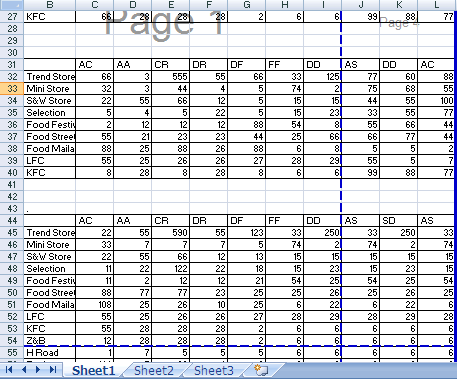Changing Your Page View
One of the slickest new features in Excel 2007 is Page Layout View, which shows your worksheet divided up into pages. In other words, you are able to visualize your printed output as you work. Page Layout View is one of three worksheet views, which are controlled by the three icons in the right side of the status bar. These views are also available in the View> Workbook Views group of the Ribbon. The three view options are:
Normal View:
The default view of the worksheet. This view may or may not show page breaks.
Page Layout View:
A view that shows individual pages.
Page Break Preview:
A view that lets you manually adjust the page breaks.
Just click one of the icons to change the view. You can also use the Zoom slider to change the magnification from 10% (a very tiny bird's eye view) to 400% (very large, for showing fine detail). These views can help with printing.
Normal View
Most of the time when you work in Excel, you will use Normal View. Normal View displays page breaks in the worksheet. The page breaks are indicated by horizontal and vertical dotted lines. These page break lines adjust automatically if you change the page orientation, add or delete rows or columns, change row heights, change column widths, and so on. For example, if you find that your printed output is too wide to fit on a single page, you can adjust the column widths (keeping an eye on the page-break display) until the columns are narrow enough to print on one page.
Page breaks are not displayed until you print (or preview) the worksheet at least one time.
If you'd prefer not to see the page break display in Normal View mode, choose Office> Excel Options and select the Advanced
tab. Scroll down the section titled Display Options For This Worksheet and remove the check mark from Show Page Breaks. This
setting applies only to the active worksheet. Unfortunately, the option to turn off page break display is not in the Ribbon,
and it's not even available for inclusion on the Quick Access Toolbar.
A worksheet in Normal View mode, zoomed out to show multiple pages. Notice the dotted lines that indicate page breaks.
Page Layout View
Page Layout View is the ultimate print preview. Unlike the old print preview, this mode is not a view only mode. You have complete access to all Excel commands. In fact, you can use Page Layout View all the time if you like.
A worksheet in Page Layout View, zoomed out to show multiple pages. Notice that The page header & footer (if any) appear on each page, giving you a true preview of the printed output.
If you move the mouse to the corner of a page while in Page Layout View, you can click to hide the white space in the margins. Doing so gives you all the advantages of Page Layout View, but you can see more information on screen because the unused margin space is hidden.
In Page Layout View, the worksheet resembles printed pages.
Page Break Preview
Page Break Preview displays the worksheet and shows where the page breaks occur. This view mode is different from Normal View mode with page breaks turned on. The key difference is that you can drag the page breaks. Unlike Page Layout View, Page Break Preview does not display headers and footers.
When you enter Page Break Preview mode, Excel performs the following:
- Changes the zoom factor so that you can see more of the worksheet.
- Displays the page numbers overlaid on the pages.
- Displays the current print range with a white background; nonprinting data appears with a gray background.
- Displays all page breaks as draggable dashed lines.

When you change the page breaks by dragging, Excel automatically adjusts the scaling so that the information fits on the pages, per your specifications.
In Page Break Preview mode, you still have access to all of Excel's commands. You can change the zoom factor if you find the text to be too small.
To exit Page Break Preview mode, just click one of the other View icons in the status bar.
